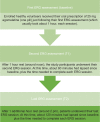Electroretinographic modifications induced by agomelatine: a novel avenue to the understanding of the claimed antidepressant effect of the drug?
- PMID: 24899809
- PMCID: PMC4038423
- DOI: 10.2147/NDT.S63459
Electroretinographic modifications induced by agomelatine: a novel avenue to the understanding of the claimed antidepressant effect of the drug?
Abstract
Background: Agomelatine, the first melatonergic antidepressant, has been postulated to enhance the dopaminergic activity at the central nervous system by 5-hydroxytryptamine receptor type 2C (5-HT2C) antagonism, yet the impact of melatonergic agonism on this pathway is unclear. Previous studies employing simplified, yet reliable, proxy (retinal) measures of the central nervous system dopaminergic activity, namely the standard electroretinogram (ERG) technique, suggested a reduction of the dopaminergic activity of the main ERG parameter, the b-wave, by pure melatonin, notably a hormone devoid of any antidepressant activity. Therefore, the antidepressant effects of the melatonergic antidepressant drug agomelatine should be reflected by a differential b-wave trend at ERG versus the effect exerted by pure melatonin, which was eventually found to be due to a contrasting effect on central dopaminergic transmission between the two drugs.
Objective and methods: The aim of the present preliminary ERG study carried out on healthy volunteers (n=23) receiving agomelatine was to explore the impact of this antidepressant drug on b-wave amplitude and latency of cones in daylight conditions using standard ERG.
Results: As postulated, agomelatine induced an enhancement of retinal dopaminergic activity, in contrast to what has been previously documented for melatonin.
Conclusion: Given the limits of this explorative study, especially the lack of a control group and that of a luminance response function to measure retinal sensitivity, further studies in clinical samples are recommended to allow more tenable conclusions about the potential role of ERG in discriminating between 5-HT antagonism and melatonergic (MT) agonism in relationship to the claimed antidepressant effect of agomelatine.
Keywords: 5-HT2C; ERG; dopamine; electroretinogram.
Figures


Similar articles
-
A systematic, updated review on the antidepressant agomelatine focusing on its melatonergic modulation.Curr Neuropharmacol. 2010 Sep;8(3):287-304. doi: 10.2174/157015910792246227. Curr Neuropharmacol. 2010. PMID: 21358978 Free PMC article.
-
Critical appraisal and update on the clinical utility of agomelatine, a melatonergic agonist, for the treatment of major depressive disease in adults.Neuropsychiatr Dis Treat. 2009;5:563-76. doi: 10.2147/ndt.s5453. Epub 2009 Nov 16. Neuropsychiatr Dis Treat. 2009. PMID: 19966905 Free PMC article.
-
Agomelatine: a novel antidepressant.Innov Clin Neurosci. 2011 Nov;8(11):10-4. Innov Clin Neurosci. 2011. PMID: 22191083 Free PMC article.
-
Role of melatonin, serotonin 2B, and serotonin 2C receptors in modulating the firing activity of rat dopamine neurons.J Psychopharmacol. 2014 Feb;28(2):162-7. doi: 10.1177/0269881113510071. Epub 2013 Nov 4. J Psychopharmacol. 2014. PMID: 24189440
-
Melatonergic drugs for therapeutic use in insomnia and sleep disturbances of mood disorders.CNS Neurol Disord Drug Targets. 2012 Mar;11(2):180-9. doi: 10.2174/187152712800269740. CNS Neurol Disord Drug Targets. 2012. PMID: 22483286 Review.
Cited by
-
Molecular Regulation of the Melatonin Biosynthesis Pathway in Unipolar and Bipolar Depression.Front Pharmacol. 2021 Apr 26;12:666541. doi: 10.3389/fphar.2021.666541. eCollection 2021. Front Pharmacol. 2021. PMID: 33981243 Free PMC article.
-
Colour vision defects in schizophrenia spectrum disorders: A systematic review.Neurosci Appl. 2024 Feb 12;3:104046. doi: 10.1016/j.nsa.2024.104046. eCollection 2024. Neurosci Appl. 2024. PMID: 40656100 Free PMC article. Review.
-
Agomelatine beyond borders: current evidences of its efficacy in disorders other than major depression.Int J Mol Sci. 2015 Jan 5;16(1):1111-30. doi: 10.3390/ijms16011111. Int J Mol Sci. 2015. PMID: 25569089 Free PMC article. Review.
-
Exploring the ElectroRetinoGraphy as a biomarker for predicting and monitoring therapeutic response to antidepressants in major depressive disorder: study protocol for the MESANTIDEP trial.Front Psychiatry. 2025 Apr 25;16:1501166. doi: 10.3389/fpsyt.2025.1501166. eCollection 2025. Front Psychiatry. 2025. PMID: 40352365 Free PMC article.
-
Effects of medications on the human electroretinogram: A comprehensive review.Surv Ophthalmol. 2025 Apr 12:S0039-6257(25)00067-0. doi: 10.1016/j.survophthal.2025.04.003. Online ahead of print. Surv Ophthalmol. 2025. PMID: 40228746 Review.
References
-
- Diagnostic and Statistical Manual of Mental Disorders. 4th ed. Washington, DC: American Psychiatric Association; 1994.
-
- Diagnostic and Statistical Manual of Mental Disorders. 5th ed. Washington, DC: American Psychiatric Association; 2013.
-
- Lopresti AL, Maker GL, Hood SD, Drummond PD. A review of peripheral biomarkers in major depression: the potential of inflammatory and oxidative stress biomarkers. Prog Neuropsychopharmacol Biol Psychiatry. 2014;48:102–111. - PubMed
-
- Fornaro M, Aguglia E, Dell’Osso L, Perugi G. Could the underestimation of bipolarity obstruct the search for novel antidepressant drugs? Expert Opin Pharmacother. 2011;12(18):2817–2831. - PubMed
LinkOut - more resources
Full Text Sources
Other Literature Sources
Research Materials

